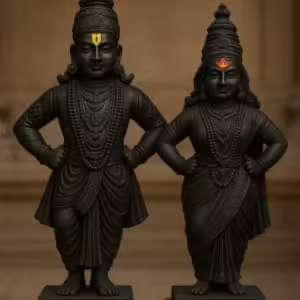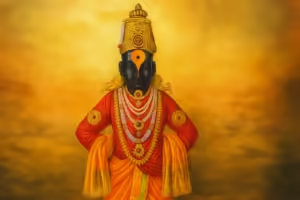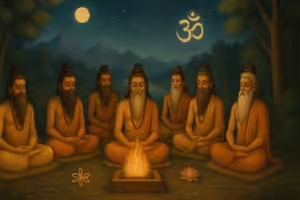Introduction
Janmashtami is one of the most important and sacred festivals in Hinduism, celebrated as the birth anniversary of Lord Krishna. This festival is celebrated with great enthusiasm across India and holds special religious significance for Hindu devotees worldwide. Lord Krishna is considered the eighth incarnation of Lord Vishnu, who descended on Earth to destroy evil and establish righteousness. In this blog, we will explore the religious significance of Janmashtami, the associated stories, and the rituals followed to celebrate it.
Table of Contents
The Birth of Lord Krishna and Its Significance
Lord Krishna was born in the Dwapara Yuga when sin and tyranny had taken over the Earth. According to mythology, Krishna was born in a prison in Mathura. His uncle Kansa had heard a prophecy that Devaki’s eighth son would be the cause of his death. Fearing this, Kansa imprisoned his sister Devaki and her husband Vasudeva. Kansa killed Devaki’s first seven sons, but when the eighth son, Krishna, was born, he was miraculously saved by divine intervention. Vasudeva safely carried him to Gokul, where Nanda and Yashoda took care of him. This event symbolizes the triumph of righteousness over evil.
Throughout his life, Krishna performed many divine acts, such as the killing of Kansa, lifting Govardhan Mountain, and delivering the Bhagavad Gita to Arjuna during the Mahabharata war. Krishna is worshipped as the ideal friend, lover, teacher, and king. His teachings and actions continue to inspire devotees to this day.

Religious Significance of Janmashtami
The significance of Janmashtami goes beyond the birth of Lord Krishna; it is also a festival of spiritual awakening and religious devotion. This day reminds us of the victory of righteousness over evil. The story of Krishna’s birth teaches us that no matter how difficult the circumstances, faith in God and truth will always triumph.
On this day, devotees observe fasts, participate in religious rituals, and recall the events of Krishna’s life. Krishna’s childhood pastimes, such as stealing butter and performing the Rasa Lila, hold a special place in the hearts of devotees. The life of Lord Krishna serves as a beacon of love, truth, and the observance of dharma (righteousness). Every year, Janmashtami gives us an opportunity to renew these values in our lives.
Rituals of Janmashtami
Special prayers, fasts, and rituals mark the celebration of Janmashtami. These rituals hold deep religious and cultural significance. Devotees follow a strict regimen of worship and fasting on this day. Let us explore some of the major rituals observed on Janmashtami:
1. Fasting and Vows
On Janmashtami, devotees observe fasts as a symbol of their devotion and dedication to Lord Krishna. Those who fast consume only water and fruits throughout the day and break their fast at midnight, the time of Krishna’s birth, by consuming food items made from milk and fruits. This fast is considered particularly difficult but is seen as an act of love and devotion to the Lord.
2. Midnight Puja
Since Lord Krishna was born at midnight, the main highlight of Janmashtami celebrations is the midnight worship of the deity. At 12 o’clock midnight, temples and homes are filled with the joyous celebration of Krishna’s birth. The deity is placed in a cradle and swung, accompanied by devotional songs and prayers, celebrating the divine event.
3. Tableaus and Butter Thief Act
On Janmashtami, special tableaus (known as “jhankis”) and plays representing Krishna’s childhood pastimes are organized. These tableaus depict various events from Krishna’s life, especially his mischievous acts of stealing butter, lifting Govardhan Mountain, and performing the Rasa Lila. Children are dressed up as Krishna and Radha, and they participate in these displays, recreating scenes from the deity’s life.
4. Dahi Handi
The day after Janmashtami, the famous Dahi Handi event is held in Maharashtra and other states. This ritual symbolizes Lord Krishna’s act of stealing butter. A pot filled with yogurt or buttermilk is hung high, and young boys form human pyramids to break the pot. This event is inspired by Krishna’s childhood exploits and is celebrated with great enthusiasm.
5. Devotional Songs and Rasa Lila
During Janmashtami, devotees engage in devotional singing and dancing, known as “bhajan-kirtan.” They sing songs praising Lord Krishna and offer their devotion through music. Rasa Lila, a traditional dance form, is also performed in places like Vrindavan and Mathura, depicting the divine love story of Krishna and Radha. These events immerse devotees in spiritual bliss.
6. Temple Decoration and Night Vigil
Temples are beautifully decorated on the occasion of Janmashtami. The idols of Lord Krishna are adorned with new clothes and ornaments, and the temples are lit up with lights and flowers. Devotees stay up all night, participating in prayers and devotional songs, and focusing on meditating upon Lord Krishna.
7. Recitation and Storytelling
On Janmashtami, scriptures like the Srimad Bhagavatam and other holy texts are read aloud. Devotees listen to the stories of Lord Krishna’s life and remember his divine pastimes. Krishna’s teachings, especially the knowledge imparted in the Bhagavad Gita, are recited and discussed. These recitations help devotees connect with the Lord and immerse themselves in his divine presence.
Spiritual Perspective
Janmashtami holds immense spiritual significance beyond its religious rituals. Lord Krishna’s life and teachings inspire us to live by the principles of truth, non-violence, love, and righteousness. In the Bhagavad Gita, Krishna teaches Arjuna the paths of Karma (action), Bhakti (devotion), and Jnana (knowledge). He emphasized that while performing actions in life is important, one must do so without attachment to the results.
This teaching applies to every sphere of life—whether personal, social, or religious. Lord Krishna’s life shows us that while the path of righteousness may be difficult, truth ultimately prevails. The spiritual message of Janmashtami encourages devotees to seek inner peace and to connect with the divine.
Impact of Janmashtami on Society
Janmashtami is a symbol of unity, devotion, and spiritual awakening in Indian society. This festival brings together different communities and fosters cultural and religious heritage. Janmashtami particularly resonates with children and youth, educating them about Krishna’s divine pastimes and the lessons derived from them. The festival also strengthens religious devotion and communal harmony in society.
Conclusion
Janmashtami is celebrated as the birth anniversary of Lord Krishna with great devotion and enthusiasm across India and worldwide. This festival fills our hearts with love, devotion, and surrender towards the divine. Lord Krishna’s life and teachings remind us of the importance of truth, righteousness, and love in life. The rituals and fasts observed during Janmashtami provide devotees with the opportunity to purify their souls and feel closer to God.
Janmashtami is not just a religious celebration but a time for spiritual elevation and spreading peace and harmony in society. On this holy occasion, we must draw inspiration from the life of Lord Krishna and follow the path of righteousness, love, and truth in our lives. Jai Shri Krishna!
Read this Article in Hindi Click Here
Last Updated on August 25, 2024 by Hinditerminal.com



